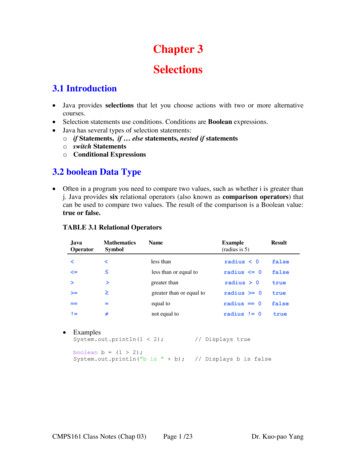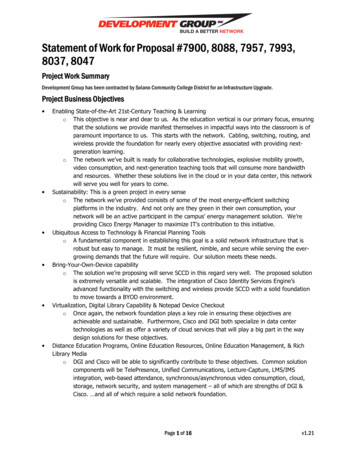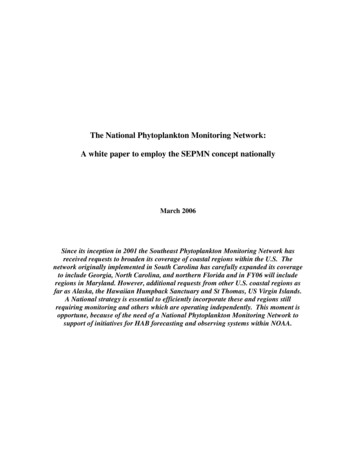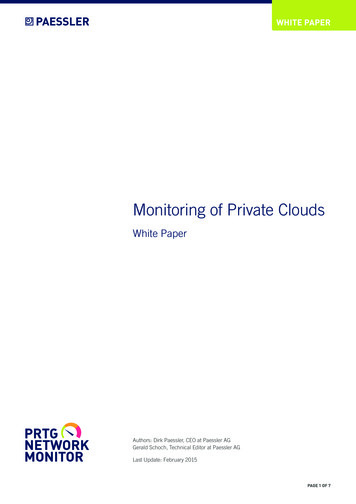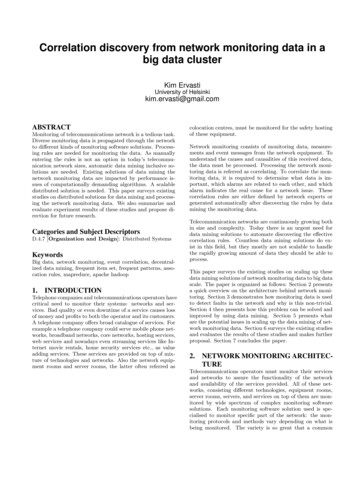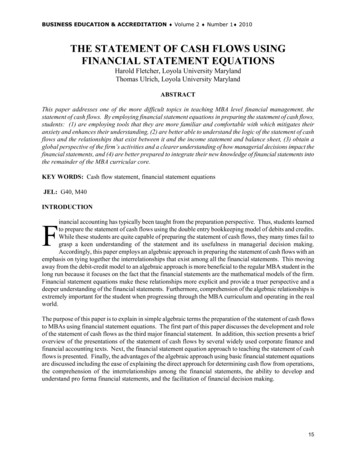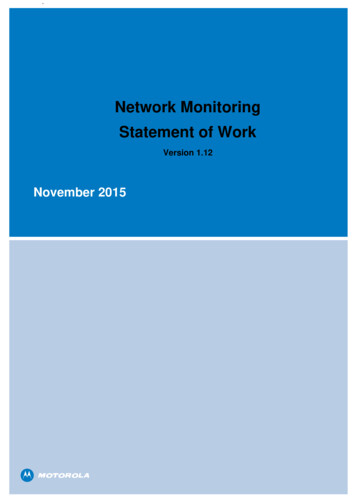
Transcription
Network MonitoringStatement of WorkVersion 1.12November 2015
Network Monitoring, Statement of WorkVersion 1.12Network Monitoring OverviewMotorola’s Network Monitoring Operations (NMO) within the Motorola Solutions SupportCenter (SSC) provides real-time fault monitoring for radio communications networks on acontinuous basis. NMO utilizes sophisticated tools for remote monitoring and eventcharacterization of your communications networks. When an event is detected, NMOtechnologists acknowledge and assess the situation, and initiate a defined response.The terms and conditions of this Statement of Work (SOW) are an integral part of Motorola'sService Agreement or other applicable agreement to which it is attached and made a partthereof by this reference.1.0Description of Network Monitoring ServicesNetwork Monitoring is a service designed to electronically monitor elements of acommunication system for events, as set forth in the Monitored Elements Table. When theSSC detects an event, (based on the severity of the event) trained technologistsacknowledge and remotely diagnose the event, and initiate an appropriate response inaccordance with the customer handling procedure. Appropriate responses could include, butare not limited to, continuing to monitor the event for further development, attempting remoteremediation via engagement of Technical Support resources, or initiating dispatch1 of a FieldServicer for onsite remediation.1.1AvailabilityNetwork Monitoring service is available 24 hours a day, 7 days a week. Network Monitoringavailability is based on the level of contracted service and defined in the Customer SupportPlan (CSP).1.2Geographic AvailabilityNetwork Monitoring is a globally provided service unless limited by data export controlregulations. Timeframes are based on the customer’s local time zone.1.3InclusionsNetwork monitoring service can be delivered on Motorola sold infrastructure as stated inMonitored Elements Table.1.4Limitations and Exclusions1.4.1Does not include monitoring of anything outside of the radio network ormonitoring of infrastructure provided by a third party, unless specificallystated. Monitored elements must be within the radio network and capable ofsending traps to the Unified Event Manager (UEM).1.4.2Additional support charges above and beyond the contracted serviceagreements may apply if it is determined that system faults were caused bythe customer making changes to critical system parameters.1.4.3The following activities are outside the scope of the Network Monitoringservice, but are optional services that are available to remote NetworkMonitoring customers at an additional cost:Approved by Motorola Solutions LGA&C 11/12/2014 Motorola 2015Page 2 of 8
Network Monitoring, Statement of WorkVersion 1.121.4.3.1 Emergency on-site visits required to resolve technical issues that cannotbe resolved by with SSC working remotely with the local customertechnical resource.1.4.3.2 System installations, upgrades, and expansions.1.4.3.3 Customer training.1.4.3.4 Hardware repair and/or exchange.1.4.3.5 Network security services.1.4.3.6 Network transport.1.4.3.7 Information Assurance.1.4.3.8 Any services not expressly included in this statement of work.1.4.4 Reference the event catalogue to confirm monitored equipment.1 Dispatch service with OnSite Response is a separate service that is required with Network Monitoring.1.5 Motorola has the following responsibilities:1.5.1. Provide dedicated connectivity through a network connection necessary formonitoring communication networks. The Connectivity Matrix further describes theconnectivity options.1.5.2If determined necessary by Motorola, provide Motorola owned equipment formonitoring system elements. If Motorola installs or replaces Motorola ownedequipment, the type of equipment and location installed is listed in theMotorola Owned & Supplied Equipment Table.1.5.3Verify connectivity and event monitoring prior to system acceptance or startdate.1.5.4Monitor system continuously during hours designated in the CSP inaccordance with the pre-defined times specified in section 1.6.2 below.1.5.5Remotely access the customer’s system to perform remote diagnosis aspermitted by customer pursuant to section 1.6.4.1.5.6 Create a case, as necessary. Gather information to perform the following:1.5.6.1 Characterize the issue1.5.6.2 Determine a plan of action1.5.6.3 Assign and track the case to resolution.1.5.7Cooperate with customer to coordinate transition of monitoring responsibilitiesbetween Motorola and customer as specified in section 1.6.13 and 1.6.13.1.1.5.8Maintain communication with the customer in the field as needed untilresolution of the case1.6 The Customer has the following responsibilities:1.6.2Allow Motorola continuous remote access to enable the monitoring service.1.6.3Provide continuous utility service to any Motorola equipment installed orutilized at customer’s premises to support delivery of the service.1.6.4 Provide Motorola with pre-defined customer information and preferences priorto Start Date necessary to complete the CSP, including, but not limited to:1.6.4.1Case notification preferences and procedureApproved by Motorola Solutions LGA&C 11/12/2014 Motorola 2015Page 3 of 8
Network Monitoring, Statement of WorkVersion 1.121.6.4.2Repair Verification Preference and procedure1.6.4.3Database and escalation procedure forms.1.6.4.4Submit changes in any information supplied to Motorola and includedin the CSP to the CSM.1.6.5 Provide the following information when initiating a service request:1.6.5.1Assigned system ID number1.6.5.2Problem description and site location1.6.5.3Other pertinent information requested by Motorola to open a Case.1.6.6Notify the SSC when customer performs any activity that impacts the system.(Activity that impacts the system may include, but is not limited to, installingsoftware or hardware upgrades, performing upgrades to the network, or takingdown part of the system to perform maintenance.)1.6.7 Allow Servicers access to equipment (including any connectivity or monitoringequipment) if remote service is not possible.1.6.8 Allow Servicers access to remove Motorola owned monitoring equipment uponcancellation of service.1.6.9 Provide all customer managed passwords required to access the customer’ssystem to Motorola upon request or when opening a case to request servicesupport or enable response to a technical issue.1.6.10 Pay additional support charges above and beyond the contracted serviceagreements that may apply if it is determined that system faults were causedby the customer making changes to critical system parameters1.6.11 Obtain all third party consents or licenses required to enable Motorola toprovide the monitoring service.1.6.12 Cooperate with Motorola and perform all acts that are reasonable ornecessary to enable Motorola to provide the services described in this SOW.1.6.13 Contact Motorola to coordinate transition of monitoring when monitoringresponsibility is to be transferred to or from Motorola. (I.e. normal businesshours to after-hours monitoring) as set forth in pre-defined informationprovided by customer CSP.1.6.13.1Upon contact, customer must provide customer name, site id, statuson any open cases, severity level, and brief description of case and actionplan to Motorola.1.6.14 Acknowledge that cases will be handled in accordance with the times andpriorities as defined in the Event Definition table- Appendix A .1.6.15 Cooperate with Motorola and perform all acts that are reasonable ornecessary to enable Motorola to provide the Network Monitoring service.Approved by Motorola Solutions LGA&C 11/12/2014 Motorola 2015Page 4 of 8
Network Monitoring, Statement of WorkVersion 1.12The event types are based on the defined levels as follows:Appendix AEngagement MatrixSeverity Severity DefinitionLevelEngagement Times1Response provided 24 hours, 7days a week, including USHolidays.This is defined as a critical/major incidentthat causes the system and/orinfrastructure to experience a loss of callprocessing functionality and no workaround or immediate solution is available.The following are examples of this kind offailure:2o33% of call processing resourcesimpairedoRemote Site/sub-system severedoSite Environment alarms:oSmokeoUnauthorized accessoTemperatureoPower failureThis is defined as a moderate/minorincident that causes the system to operatewith a continuous reduction in capacity orfunctionality of core services (core servicesinclude, voice, data or networkmanagement).Response provided 8 x 5 onstandard business days, which isnormally Monday through Friday8AM to 5PM, excluding USHolidays.The following are examples of this kind offailure:3oLess than 33% of call processingresources impairedoFailure of a single redundantcomponentThis is defined as a minor issue, which haslittle or no impact on the functionality,efficiency or usability of core services. Thefollowing are examples of this kind ofseverity:Approved by Motorola Solutions LGA&C 11/12/2014Response provided 8 x 5 onstandard business days, which isnormally Monday through Friday8AM to 5PM, excluding USHolidays. Motorola 2015Page 5 of 8
Network Monitoring, Statement of WorkVersion 1.12oFaults that have no impact in howthe user perceives the system toworkoIntermittent issuesoRequests for informationoPreventive Maintenance or upgraderelated workConnectivity MatrixRequest connectivity 8 weeks in advance of service start dateSystem TypeConnectivitySet up andMaintenanceASTRO 25ASTRO 25Internet VPNT1MotorolaMotorolaMotorola Owned & Supplied Equipment TableEquipment TypeFirewall/RouterService Delivery Management ServerApproved by Motorola Solutions LGA&C 11/12/2014Location InstalledMaster SiteMaster Site for each Zone Motorola 2015Page 6 of 8
Network Monitoring, Statement of WorkVersion 1.12Monitored Elements TableMaster Site InfrastructureRF Site EquipmentDispatch Site EquipmentServers & Back up ServersChannelsConsolesMOSCAD (digital inputs &RS232 serial alarms)MOSCAD (digitalAIS Serversinputs & RS232 serialalarms)TRAKRF SiteCommunication PathOperator Position (OP)Core LAN SwitchSwitchMotorola Gold EliteGateway (MGEG)Packet Data Gateway (PDG)Site ControllerCall ProcessorRadio Network Gateway(RNG)RouterLogging Replay StationZone Database Server (ZDS)SiteAmbassador (AMB)Gateway RouterGateway RouterClient StationController – Zone & DomainNetwork TimeProtocol (NTP)Voice Processing Module(only within the RNI)(VPM)Firewall Manager ServersFirewallMCC 7500 IP LoggingRecordersAir Traffic Router (ATR)SmartX SiteConverter (only theconverter, not thelegacy sites)MCC 7100 (only within theRNI)Unified Event Manager(UEM)Zone Statistical Server (ZSS)Install Server*Some or all of the above equipment may be monitored depending on system configuration and need. Otherequipment (not listed) may be monitored as an option, consult with your Customer Support Manager for details.Approved by Motorola Solutions LGA&C 11/12/2014 Motorola 2015Page 7 of 8
Network Monitoring service is available 24 hours a day, 7 days a week. Network Monitoring availability is based on the level of contracted service and defined in the Customer Support Plan (CSP). 1.2 Geographic Availability Network Monitoring is a globally provided service unless limited by data export control regulations.

